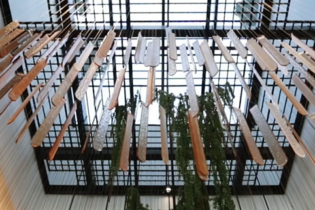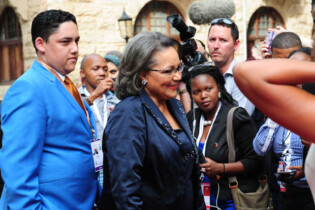Good morning, colleagues, and thank you for the opportunity to share some thoughts with you about the state of South Africas travel and tourism sector. Even though the time allocated might not be enough to reflect on all the issues that you may have on your mind, I hope we can at least cover the most salient ones.
At the end of last week, industry players met with government for what was a very constructive stock-taking. We have much to celebrate, but, of course, we can never become complacent in this ever-changing market and consumer environment. Before turning to a number of local issues, let me start with the global perspective: Travel and tourism is the third largest industry in the world. At 9% of global gross domestic product (GDP), it is larger than automotive manufacturing, which stands at 8%, mining at 8%, and chemicals manufacturing at 7%. There are only two industries that are larger than tourism: These are financial services and banking, and education and communication. The size of our sector has always been underestimated, but through our efforts in the G20 and the United Nations World Tourism Organisation (UNWTO), heads of state today recognise it as a major growth sector. The industry is expected to create an additional 21 million direct jobs over the next decade, taking total direct employment to over 120 million, which constitutes more than 3,5% of total employment excluding the multiplier effect. It is further projected that we will see average annual growth of between 3% and 3,5% between now and 2020.
In this global context, South Africas reputation as a premier global leisure destination is firmly established. We are growing steadily and have taken lessons from the economic downturn. We understand that we have to balance domestic, regional and long-haul arrivals as well as leisure and business tourism. We further realise that we must invest early in the growth markets of the future, as economic conditions in traditional markets can change very quickly.
In order to be competitive, we, as a sector, have to market and sell unique experiences as well as retain and grow the market share of outbound operators. Tourists vote with their feet and, therefore, we must keep our eyes on ever-changing consumer preferences, diversify our products, maintain excellent service, and ensure that we continue to deliver value for money.
In the 2010/11 World Economic Forum Global Competitive Report, South Africa is ranked 54th overall, and we remain the highest ranked country in sub-Saharan Africa. Geoffrey Lipman, the doyen of international tourism, will elaborate on this in a moment, and I hope he will also focus on his impressions of where we can up our game.
During the last five years, South Africa has outpaced the growth of all competitor locations in the leisure arrivals category. Foreign direct spend in rand terms has grown faster than arrivals, with an 11% per-annum growth rate. South Africas tourism industry has also managed to build on the momentum achieved during a record-breaking 2010, by growing an additional 3,3% and attracting over 8,3 million international tourists in 2011.
In the near term, we remain cautiously optimistic about growth in international arrivals. Without denying the pain brought about by the worldwide economic recession, I think our sector has nevertheless shown remarkable resilience followed by a reasonable recovery, and, by all indications, we will continue to exceed international growth rates in 2012. The World Travel and Tourism Council (WTTC) expects global tourism GDP to grow at 2,8% this year, which is down from 3% in 2011. In terms of volume, the UNWTO tells us that global tourist arrival growth has been a strong 5,4% during the first four months of 2012. Some flattening out is on the horizon, though, and by year-end, we expect arrivals growth worldwide to have averaged out in the 34% bandwidth.
In South Africa, we recently reported excellent results for the first few months of 2012: Tourist arrivals to our country increased by an overall 10,5% year-on-year during the first quarter, and overseas arrivals by nearly 18%. Just last week, the latest Statistics SA accommodation figures underscored this trend: Total income for the accommodation industry for the second quarter of 2012 increased by 11,2%, and the number of stay unit nights sold for the second quarter of 2012 increased by 8,2%, both compared to the same period in 2011.
Overall, growth can be ascribed to the fact that we have crafted and byandlarge protected our value proposition; we segmented our markets carefully; our decisions are driven by meticulous market research, and we have invested and continue to invest in carefully targeted brand building and marketing. Consistent with the portfolio approach, we have always strived to strike the right balance between the spend on global branding and in-country marketing, and between mature and emerging markets.
The regional African tourist market is undoubtedly one of our most important tourist markets, and contributed over 73% of South Africas total tourist arrivals and more than R50 billions revenue in 2011. We will be investing R218 million over the next three financial years to support South African Tourisms efforts to grow our share of the African market. The regional Africa hub strategy is now ready to be rolled out.
Let me turn to a number of prominent issues, many of which I know are on your minds also.
Aviation remains the midwife to long-haul tourism. Specific focus should be placed on creating space for the new model of low-cost airlines and advancing competition in the skies. As a long-haul destination, we are heavily dependent on airlift capacity. We are working with the Department of Transport and other partners to review the 2006 airlift strategy, which we will be taking back to Cabinet soon.
Many of us understand that the bureaucracy and costs involved in applying for and issuing visas are a major impediment to foreigners wishing to visit our shores, and to our own people to travel on our continent. We have an opportunity here to leapfrog by doing two things right. In an era of globalisation, technology offers many opportunities to enhance security, while also facilitating travel and tourism. By introducing e-visas, which I believe is possible during the next few years, we will not only grow tourism volumes, but we will also create many new job opportunities.
At the G20 summit in Mexico in June this year, tourism was for the first time ever recognised by heads of state as a priority sector to spur global economic recovery. We also secured a commitment by G20 heads of state to work on advancing travel facilitation. This provides new momentum to our efforts to advance e-visas, regional visas and visa waiver programmes between key source markets in the next few years.
Furthermore, I believe there are opportunities to accelerate the creation of regional visa schemes. This would allow our international visitors and intra-African travellers to move more freely and efficiently, to the benefit of our continent.
I am therefore glad to report that the National Department of Tourism(NDT) and the Department of Home Affairs have signed an agreement to collaborate more closely on removing visa barriers, which will be implemented in collaboration with industry. The challenge will be to find the right balance between national security imperatives and the effective promotion of visitor flows to our country.
Turning to service levels: At the beginning of this year, the NDT in partnership with the South African Bureau of Standards (SABS) developed a set of tourism service excellence standards. The implementation and application of standards and self-assessment tools will position tourism as a service-driven industry, and South Africa as a globally competitive service economy. We therefore urge industry to become active participants and improve their service levels in line with world-class standards.
This leads me to the grading of establishments, which I know has been the topic of much debate in the last few months. Despite the various concerns raised by establishment owners when the new, stricter and more comprehensive grading criteria were launched, it is most encouraging to note that the Tourism Grading Council of South Africa (TGCSA) managed to bring 1 165 new properties into the fold during the previous financial year. This is testament to excellent stakeholder engagement initiatives. The three-year review of the grading criteria will be taking place in a few weeks time. We want to hear your views on how to secure South Africas international competitiveness as a tourism destination, using grading as one of the vehicles.
With regard to skills development: NDT provides support with tourism infrastructure development, and also aids in expanding the tourism skills base. We must ensure that our people particularly also our small, medium and micro-sized enterprises (SMMEs) share in the benefits of meetings, incentives, conferencing and exhibitions (MICE) tourism growth. We must also understand that we need to create special skills sets to achieve service excellence. In this regard, the Department has very progressive programmes, such as the National Unemployed Youth Hospitality Placement Programme, the International Placement Programme of Unemployed Graduates, the National Youth Chefs Training Programme, to name but a few.
Chairperson, in line with our efforts to build a competitive destination, we have also established the National Conventions Bureau. The conferencing industry holds immense global potentialto boost our international arrivals further. In 2011, 10 000 association meetings rotated worldwide, 6500 of which were regional and 3500 international. Africa hosted only 304 meetings, and South Africa only 86. We are currently ranked number 37 globally. This indicates that even though we have managed to secure 200 international conferences for the next five years, which are estimated to attract 300 000 delegates and provide a boost of more than R1,6 billion for the economy, there is still much room left to grow.
This then brings me to domestic tourism. We are committed to ensure that our domestic tourism strategy and campaign delivers measurable results. Once again, however, this will only be achievable if we succeed in building a partnership between government and the private sector. Since the launch of the domestic tourism strategy and the new domestic marketing campaign, we have seen a number of industry players advertising their products and experiences through national media, in particular TV and radio. This is a very welcome development.
Finally, I know that, over the years, we have all invested time to improve the accuracy of our tourism statistics, which include the tourist accommodation survey and tourism departure survey as well as arrivals data. All of these are based on sound methodological approaches developed in consultation with key tourism stakeholders and in line with global best practice definitions agreed to under the United Nations world body for tourism. Recently, a team comprising Statistics SA, the Tourism Business Council of South Africa (TBCSA) and the NDT reviewed the various statistical processes pertinent to the collection and processing of international tourist arrival statistics and the tourist accommodation survey. This process has led to renewed confidence in the integrity of the official tourism statistics. It is critical that we eliminate any information asymmetries, that we work from the foundation of commonly agreed definitions and methodologies, and that we all have the discipline to communicate only credible data stripped of emotion and sectional interests.
In conclusion, when we adopted the National Tourism Sector Strategy, which represents a common vision and a collective visualisation of where we see our sector by 2020, we, all the roleplayers in the industry, made a commitment to the effective implementation of this strategy.
One year down the line, we have consolidated our growth path. We have put in place important building blocks and an upstream reservoir for future growth. Also, we did not place all our eggs in one basket for that, the international business climate is just too unstable. With loads of backbone, flexibility and innovation, we have steered our industry through the most difficult times. Though positive news motivates us and our collective efforts remain on track, our challenges must also inspire us to do even better.
I thank you






